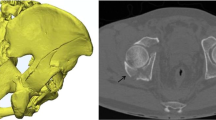Abstract
Purpose
Unstable posterior fracture-dislocation of the hip is determined by the wall defect or acetabular fracture index. The unstable hip is a result of inadequate posterior acetabular coverage of the femoral head from the posterior acetabular wall fracture. In order to measure total posterior acetabular coverage of the femoral head and avoid using the contralateral acetabulum as a calculation reference, the posterior acetabular arc angle of the femoral head was measured to assess stability of posterior fracture-dislocation of the hip.
Methods
Using coronal computed tomography (CT) scan of the normal contralateral acetabulum at the level of the widest acetabular diameter and thinnest medial wall of 60 acetabular fractures, posterior acetabular arc angles of the femoral head in intact, 20 % and 50 % defects of posterior acetabular walls were measured. The angles were measured from the acetabular centre to the thinnest medial wall and to the top, inner cortex of 80 % and 50 % posterior acetabular walls.
Results
Average intact, 80 % and 50 % posterior acetabular walls were 33.82 ± 4.30, 26.88 ± 3.33 and 16.91 ± 2.15 mm which corresponded to 92.25 ± 11.34, 77.42 ± 10.04 and 50.63 ± 6.58° of posterior acetabular arc angles of the femoral head. The intraclass correlation coefficient (ICC) of the measurements including correlation of conversion of posterior acetabular wall depths to posterior acetabular arc angles of the femoral head were more than 0.82 and 0.89.
Conclusions
The measurement technique of posterior acetabular arc angle of the femoral head has strong reliability. Therefore, stable or unstable posterior fracture-dislocation of the hip can be determined in terms of more than 77 degrees or less than 50 degrees of posterior acetabular arc angles of the femoral head instead of less than 20 % or more than 50 % posterior acetabular wall defect.



Similar content being viewed by others
References
Keith JE Jr, Brashear HR Jr, Guilford WB (1988) Stability of posterior fracture-dislocations of the hip. Quantitative assessment using computed tomography. J Bone Joint Surg Am 70(5):711–714
Calkins MS, Zych G, Latta L et al (1988) Computed tomography evaluation of stability in posterior fracture dislocation of the hip. Clin Orthop Relat Res 227:152–163
Vailas JC, Hurwitz S, Wiesel SW (1989) Posterior acetabular fracture-dislocations: fragment size, joint capsule, and stability. J Trauma 29(11):1494–1496
Moed BR, Ajibade DA, Israel H (2009) Computed tomography as a predictor of hip stability status in posterior wall fractures of the acetabulum. J Orthop Trauma 23(1):7–15
Kohn E (2001) Geometry (Cliffs quick review). Hungry Minds, New York
Matta JM, Merritt PO (1988) Displaced acetabular fractures. Clin Orthop 230:83–97
Rosner B (2011) Fundamentals of biostatistics, 7th edn. Thomson-Brooks/Cole, Boston
Jackson SL (2009) Research methods and statistics: a critical thinking approach. Thomson/Wadsworth, Belmont
Author information
Authors and Affiliations
Corresponding author
Rights and permissions
About this article
Cite this article
Harnroongroj, T., Suangyanon, P., Tharmviboonsri, T. et al. Posterior acetabular arc angle of the femoral head assesses instability of posterior fracture-dislocation of the hip. International Orthopaedics (SICOT) 37, 1141–1145 (2013). https://doi.org/10.1007/s00264-013-1870-0
Received:
Accepted:
Published:
Issue Date:
DOI: https://doi.org/10.1007/s00264-013-1870-0




